Pages lxxv-xcix
Magna Britannia: Volume 5, Derbyshire. Originally published by T Cadell and W Davies, London, 1817.
This free content was digitised by double rekeying. Public Domain.
Gentry. (fn. n1)
Arkwright, of Willersley-hall.—The founder of this family was the late Sir Richard Arkwright, who, from an humble origin, acquired opulence by the industrious application of his extraordinary mechanical talents, to the improvement of tbe cotton manufacture. He was sheriff of the county in 1786, and the same year created a knight. In 1782 he purchased the Willersley estate, and, in 1788, built Willersley-hall, which is now the residence of his son, Richard Arkwright, Esq. M.P.

Arms granted in 1787:—Arg., on a mount, Vert, a cotton tree fructed, Proper, and, on a chief, Azure, between two besants, an inescutcheon of the field, charged with a bee, volant, Proper.
Crest: — An eagle rising, Or, in the beak, pendant by a ribband, G., an escocheon, Azure, thereon a hank of cotton, Argent.
Bagshaw, of Abney, and of the Ridge. — These two branches of Bagshaw were of considerable antiquity in the Peak. They bore the same arms, and were no doubt originally from the same stock; but it does not appear by Glover's pedigree in the earliest visitation of Derbyshire, how they were connected. The elder line of the Abney branch became extinct towards the latter end of Queen Elizabeth's reign by the death of Nicholas Bagshaw who had two daughters. The Bagshaws of Hucklow became representative of the family. The Reverend William Bagshaw, an eminent puritan divine, known by the name of the Apostle of the Peak, was the eldest son of the William Bagshaw, of Hucklow and Abney; he lived at Ford which has since been the. chief residence of the family. The present male representative is the Reverend William Bagshaw of Wormhill. The Bagshaws of the Oaks were descended from a younger son of the Bagshaws of Hucklow. John Bagshaw, the last of this branch, died in 1791. In the year 1801, William Chambers Darling being maternally descended through the family of Chambers, from Richard Bagshaw, sometime of Castleton and the Oaks; on coming into possession of the latter, which is now his seat, took the name of Bagshaw by the King's sign manual, and had a grant of the arms of Bagshaw, with a difference. He was knighted in 1805. The Bagshaws became possessed of theOaks by marrying the heiress of Gill.

The family of Bagshaw of the Ridge became extinct by the death of Thomas Bagshaw, Esq., in 1721. One of his daughters and coheiresses married William Fitzherbert, Esq. of Tissington, and the Ridge estate was settled on her and her issue male. An heiress of the Cokaines married into this family.
Arms of Bagshaw of the Ridge: — Or, a bugle horn, Sable, between three roses, Proper.
Crest: — An arm couped at the elbow and erect, Proper, grasping a bugle horn, Sable, stringed, vert.

The arms of Bagshaw, of Abney, were not proved in 1634: the following have been granted to their descendant, Sir William Chambers Bagshaw; — Per pale, Erminois and Gules, a bugle stringed between three roses, all counter-changed, barbed, and seeded, Proper.
Crest:—A dexter cubit arm issuing out of the clouds, the hand Proper, holding a bugle-horn, Or, the handle Sable, within the strings a rose, Gules.
Bainbrigge, of Derby.—A branch of the Bainbrigges of Lockington, in Leicestershire, of which J. Bainbrigge, Esq., is the present representative, have been settled at this place somewhat more than a century. It does not appear whether they are descended from William Bainbrigge of Derby, who, in 1581 or 1582, had a grant of arms somewhat varying from those of Bainbrigge of Lockington, or whether the said William left any descendants.

Arms of Bainbrigge, of Lockington: — Arg. a chevron embattled, between three battle-axes, Sable.
Arms granted to William Bainbrigge of Derby, 24 Eliz.: — Arg. a chevron, Ermines, between three battle-axes, Sable.
Crest: — A demi-arm armed, the gauntlet, Or, holding a battle-axe, Sable, mantled, G., doubled, Argent.
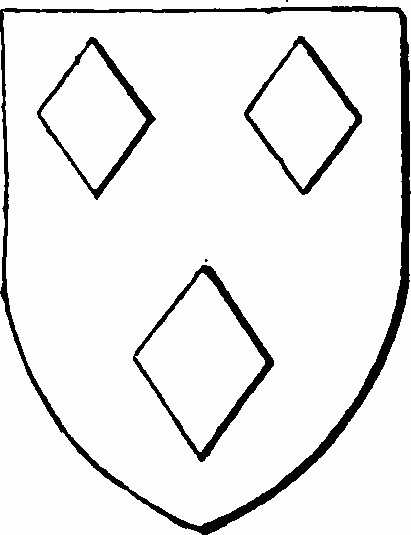
Balguy, of Aston in the Peak. — This ancient family, which had been settled in the Peak for many generations, is supposed to have been descended from that of Baguly, of Baguly in Cheshire: the arms are the same. The present representative is John Balguy, Esq., of Duffield, one of His Majesty's Justices of the Great Sessions for Wales, and Recorder of Derby. An heiress of Brailsford, of Norton, and a coheiress of Lee, of Lancashire, have married into this family.
Arms: — Or, three lozenges, Azure, two and one.
Crest: — A bear passant, Proper, collared and chained, Or.
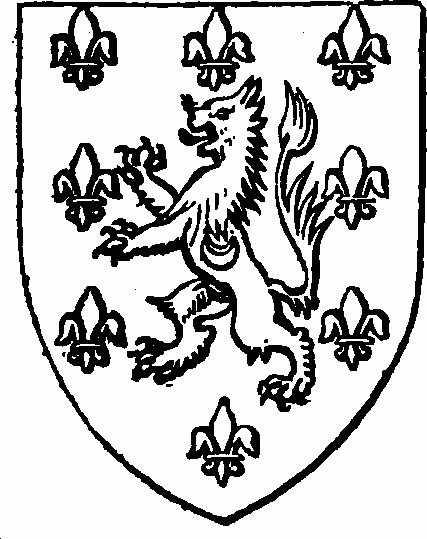
Beaumont, of Barrow. — Edward, a younger son of Thomas Beaumont, of Thringston, (which Thomas was second son of Sir Thomas Beaumont, of Cole-Orton, by the heiress of Maureward,) settled at Barrow, about the year 1550. John Beaumont, Esq., of Barrow, is the present representative of this branch.
Arms: — Azure, semee de lis, and a lion rampant, charged with a crescent, Or.
Crest: — A lion passant, Or, charged with a crescent.
Beresford, of Bentley.—Thomas Beresford, a younger son of the family of that name in Staffordshire, married the heiress of Hassall, of Hassall in Cheshire, and settled at Bentley in the fifteenth century. The elder line of this branch became extinct in the reign of James I. by the death of Thomas Beresford, whose heiress married the representative of the Staffordshire branch: the heiress of this elder branch married Sir John Stanhope, of Elvaston, by whom she had a daughter and heir married to Charles Cotton. Hugh, a younger son of Thomas Beresford, who first settled at Bentley, seated himself at Newton-Grange, in the parish of Ashborne, at which place they had resided for five generations in 1611. The Newton-Grange estate was sold by Richard Beresford, father of John Beresford, Esq., now of Compton, near Ashborne.
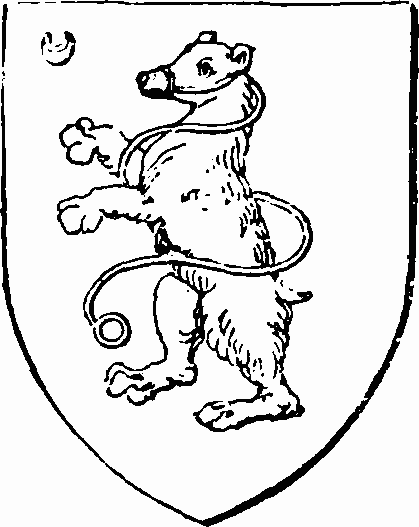
Arms: — Argent, a bear rampant, Sable, chained, collared, and muzzled, Or; a crescent for difference.
Crest: — A dragon's head, erased, Sable, pierced through the neck with a broken spear, Or, and holding a piece with the point of the same in his mouth; and headed, Argent.

Borrow, of Derby. — Isaac Borrow, father of John, who was sheriff of Derbyshire in 1688, settled at Castle-fields, adjoining to Derby: he was descended from the ancient family of Burgh, alias Stockden, of Leicestershire. His descendant (who writes his name Burrough) still possesses the site of the Castle at Derby, but resides at Chetwynd-park, in Staffordshire. His cousin, John Borrow, Esq., lord of the manor of Hulland in Ashborne, resides at Derby.
Arms granted to John Borrow, of Derby, in 1702: — Argent, on a mount in base, the trunk of an oak-tree, couped, sprouting out two branches, Proper, with the shield of Pallas thereon fastened by a belt, Gules.
Crest: — An eagle regardant, with wings expanded, standing on a mount, Proper, supporting with his dexter foot the like shield as in the arms.
Bradshaw, of Bradshaw, Windley, Holbrook, &c. — All the Derbyshire Bradshaws were descended from Bradshaw, of Bradshaw in the Peak: they became possessed of Champeyne-park, in Duffield, by marrying the heiress of Folcher, who had married the heiress of Champeyne. They were afterwards of Windley, in the same parish. The elder branch appears to have been settled at Abney in the seventeenth century. Francis Bradshaw, who was the head of the family about 1600, married a coheiress of Stafford of Eyam. George Bradshaw, Esq., the last of the elder branch, died in 1735; his sister and heiress married Galliard; the coheiresses of Galliard married Smith and Bowles; a son of the former, now of Annan, in Scotland, is representative of the elder daughter. A younger branch (descended from Anthony, a fourth son of William Bradshaw,of Windley and Bradshaw) was of Belper, and afterwards of Holbrook. This branch became extinct (at least in its elder line (fn. n2) ) by the death of the Rev. Samuel Bradshaw, of Upminster, in Essex, in 1767. Mr. Joseph Baggaley (fn. n3) (in 1768; took the name of Bradshaw, and was father of Francis Bradshaw, Esq., now of Barton-Blount.

Arms of Bradshaw, of Windley and Bradshaw: — Arg. two bendlets between two martlets, Sable; an annulet for difference, G.
Crest: — On a wreath, a hart, G., charged with an annulet, Or, standing under a vine-bough, Vert.
The Bradshaws of Marple, in Cheshire, (now extinct,) were a branch of the Derbyshire family. The celebrated President Bradshaw was of this branch, which has been for many years extinct in the male line, and is represented by the Isherwoods.

Bristowe, of Twyford. — William Bristowe, Esq., ancestor of Samuel Bristowe, Esq., now of this place, who settled at Twyford, early in the seventeenth century, was a younger son of the Bristowes of Beesthorp, in Nottinghamshire, originally of Burstowe, in Surrey, whence they took their name.
Arms: — Ermine, on a fesse, cottised, Sable, three crescents, Or.
Crest: — Out of a crescent, Or, a demi-eagle displayed, Azure.
Buxton, of Buxton, afterwards of Bradborne and Brassington. — The first of the name we meet with is Henry de Bawkestones, mentioned in a deed of the year 1256. The regular pedigrees begin about the year 1500, or somewhat earlier. The visitation of 1634 describes the family as having resided for four generations at Buxton, when the elder branch appears to have removed to Brassington, in consequence of the marriage of Richard Buxton with the heiress of Lane: his son married a coheiress of Ferne; Richard, his elder grandson, the heiress of Jackson, and left only daughters.

John, son of the first Richard, was of Ashborne in 1662. This branch appears to be extinct A younger branch of the Buxtons of Brassington settled at Youlgrave, and were some time possessed of that manor, which they sold to the Rutland family. A younger branch of this family was of Bradborne for several descents: the representative of this family is the Rev. George Buckston, now of Ashborne, whose father first adopted that spelling. Mr. Buckston's father married one of the coheiresses of Peacock; his grandfather, a coheiress of Stubbing, of West-Broughton.
Arms of Buxton, of Brassington: — Sable, two bars Arg.; on a canton of the second, a buck, trippant, of the field.
Crest: — A pelican, vulning itself, Or.

Buxton of Bradborne:—The same arms, with the addition of three mullets Arg. between the bars. This distinction appears to have been first borne by Mr. Buckston's immediate ancestor, German, second son of George Buxton, of Bradborne, who died in 1662.

Calton, of Calton in Bakewell, and of Edensor. — This family is mentioned in the list of Gentry, temp. Hen. VI.; they were then of Edensor. Calton was sold by the family to the Countess of Shrewsbury, in the reign of Queen Elizabeth. The present representative of a younger branch, settled for some generations at Chesterfield, is Mr. Richard Calton, attorney at law, of that town. The Caltons of Milton, in Berkshire, seem to have been of this family. The elder branch is supposed to be still in existence in a reduced state. (fn. n4)
Arms:—Or, a saltier engrailed, between four cross crosslets, Sable.
Crest: — A boar, passant.
Coke, of Trusley.—This family is of considerable antiquity. Hugh Coke married the heiress of Owen, of Marchington, in Staffordshire, and settled at that place in the reign of Edward III.: Thomas, his grandson, about the middle of the fifteenth century settled in Derbyshire, in consequence of his marriage with one of the coheiresses" of Odingsells, of Trusley. Richard Coke, the fifth in descent from this Thomas, married the heiress of Sacheverell, of Nottinghamshire. William Coke, grandson of Richard, married a coheiress of Beresford, of Alsop. William Coke, great-grandson of the last-mentioned William, dying without male issue in 1716, the elder branch became extinct: his daughters and coheiresses married Edward Wilmot, or the Chaddesden family, and D'Ewes Coke, of Suckley, in Worcestershire, descended from George Coke, Bishop of Hereford, a younger brother of Sir Francis Coke, of Trusley, who died in 1639. The Reyerend Francis Wilmot, Rector of Trusley, and D'Ewes Coke, Esq., of Brookhillhall, in the Nottinghamshire part of the parish of Pinxton, are the repre sentatives of this branch.

Daniel Parker Coke, Esq., of the College in Derby, descended from the Reverend Thomas Coke, Rector of Trusley, a younger brother of Robert Coke, Esq., who died in 1713, is the male representative of the family, being the eleventh in descent from Thomas Coke, who married the heiress of Odingsells. The mother of Mr. Coke was heiress of Goodwin; his grandmother, the heiress of Willet, both of Derby. Sir John Coke, Secretary of State to King Charles I., and younger brother of Sir Francis Coke, of Trusley, settled at Melbourne in this county. George Lewis Coke, Esq., the last heir male of this branch, died in 1750; his sister and sole heir married Sir Matthew Lambe, Bart., father of the present Lord Viscount Melbourne.
Arms of Coke, of Trusley: — Gules, three crescents, and a canton, Or.
Crest: — The sun in splendor, Or.
Coke, of Longford. — See Extinct Baronets.
Cotton, of Etwall. — The Cottons of Bellaport, in Staffordshire, descended from the Cottons of Ridware by a coheiress of Venables, settled at Etwall in consequence of a marriage with Mary, daughter and coheiress of Sir Samuel Sleigh, who died in 1679. William Cotton, Esq., who died in 1776, left a son of the same name, who was legitimated by act of parliament, and is the present possessor of the Etwall estate.

Arms of Cotton, of Etwall:— Azure, an eagle displayed, Argent, armed, Gules. This was the coat of Ridware, adopted by Cotton after the match with the heiress of that family: their ancient coat was — Argent, a bend, Sable, between three pellets.
Crest: — An eagle displayed.
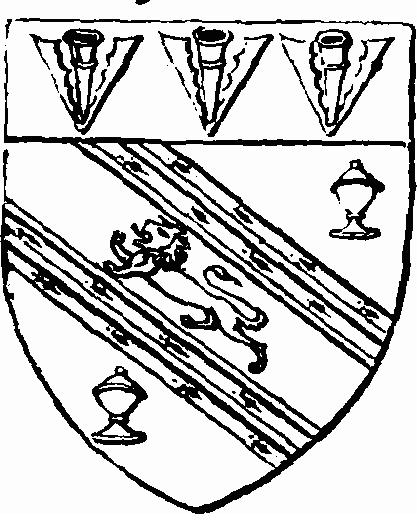
Crompton, of Derby.—This family have resided at Derby for about a century. Samuel Crompton, Esq. had a grant of arms in 1751, and served the office of Sheriff in 1768, The present representative of this family is settled in Yorkshire; his younger brother Mr. John Crompton, resides at Derby.
Arms:—Vert, on a bend, Argent, double cottised, Ermine, between two covered cups, Or, (one in the sinister chief, the other in the dexter base,) a lion passant, Gules; on a chief, Azure, three pheons, Or.
Crest: — A demi-horse rampant, issuant, vulned in the breast by an arrow, Or, shafted and feathered, Argent.

Dale, of Flagg. — The present representative of this family, of which three descents are recorded in Dugdale's Visitation (fn. n5), (1662,) is Robert Dale, Esq., of Ashborne, who served the office of sheriff in the county in 1786.
Arms: — Paly of six, Gules and Arg., a bend, Ermine, on a chief, Azure, three garbs, Or.
Crest: — On a mount, Vert, three Danish battle-axes, two in saltier and one in pale, Proper, the staves, Azure, encompassed with a chaplet of roses, alternately G. and A. banded by a ribband, Or.
Eyre, of Highlow, &c. — We find this ancient and widely spreading family first settled at Hope, where William le Eyre held a messuage and lands in the reign of Edward I. The earliest pedigree in the Heralds' Visitations, begins with Nicholas, son of this William. It appears by record, that this Nicholas was living in 1365. He had four sons. There is no account of the posterity of the two elder in the Visitations. Ralph Eyre, of Offerton in Hope, buried at Hathersage in 1493, was, probably, the son of one of them. Robert Eyre, third son of Nicholas, married the heiress of Padley, of Padley in Hathersage, by whom he had eleven sons. Robert, the eldest, settled at Padley. Sir Anthony, his great-grandson, was thrice married and had several children, but left only one surviving daughter and heiress, who marrried Sir Thomas Fitzherbert, of Norbury.
Thomas, grandson of Robert Eyre, by the heiress of Padley, being the next brother of Robert, son of Robert, settled at Highlow in Hope. The immediate male representative of this Thomas, and, in consequence, of the elder branch of Eyre of Padley, and most probably also, of the original Eyres of Hope, is Philip Gell, Esq. M.P. of Hopton, whose grandfather took the name of Gell as before mentioned.
One of the younger sons (fn. n6) of Robert Eyre, by the heiress of Padley, was of Holme-hall in the parish of Chesterfield; he married the heiress of Whittington, who was heiress also of Bakewell. Edward Eyre, grandson of this marriage, had two wives: from the first is descended Anthony Eyre, Esq., of the Grove in Nottinghamshire, many years one of the members for that county. Thomas Eyre, son of the second wife, settled at Holme-hall, and his descendants were afterwards of Newbold and of Dronfield-Woodhouse. The immediate representative of this branch is Edward Eyre, Esq., now of the Upper Crescent in Bath. Mr. Vincent Henry Eyre, son of the late Mr. Eyre, of Sheffield, and grandson of a younger brother of Mr. Edward Eyre's father, resides at Highfield in the parish of Chesterfield.
For an account of the Eyres of Hassop, (descended from Stephen, the tenth son of Ralph Eyre, by the heiress of Padley,) see Earl of Newburgh.
The Eyres of Bradway and Rowter were younger branches of the family of Eyre of Hassop. — The Bradway Eyres were descended from Adam Eyre, son of Ralph, by a coheiress of Stafford. This branch is extinct: the heiress married Tatton, and afterwards Radcliffe. Thomas Eyre, Esq., the last' of the Rowter branch, died in 1719, having bequeathed Rowter to Henry Eyre, of the Nottinghamshire family. This Henry left an only daughter married to the first Earl of Massareene.
In Dugdale's visitation is a pedigree of the Eyres of Shatton in Hope. — Thomas Eyre, of Shatton, was 56 years of age in 1662; his son Robert, aged 32, was of Edale, and had several brothers. It is not stated how they were descended, but they bore the coat of Eyre quartered with Padley. There is a pedigree in the same Visitation, of Eyre of Cuchill and Ashop, in Hope, who bore the arms of Eyre within a border, Azure. Joseph Eyre, of this branch, was 42 years of age in 1662, and had a son of the same name. There are numerous families of this name among the yeomanry, both in the parish of Hope and elsewhere in the Peak.

Arms of Eyre: — Argent, on a chevron, Sable, three quatrefoils, Or.
Crest: — A leg couped at the thigh, quarterly, Argent and Sable, spurred, Or.

Fosbrook, of Shardelow.—The ancestor of Leonard Fosbrook, Esq., being descended from a Northamptonshire family, settled at shardelow in the reign of Charles II.
Arms:—Azure, a saltier between four cinquefoils,
Gell, of Hopton. See extinct Baronets.
Gell, of Middleton and Wirksworth. — This family is descended from Thomas Gell, who died in 1626. We have not been able to ascertain thier connection with the Hopton family. (fn. n7) The representative of the Gells of Middleton and Wirksworth, at least the representative of the Derbyshire branch (fn. n8), is Philip Gell, Esq., of the Gatehouse in Wirksworth.

Arms granted in 1731: — Per bend, Arg. and Gules, a rose between two mullets of six, bendways, counterchanged.
Crest: — A greyhound, Sable, collared, Gules.
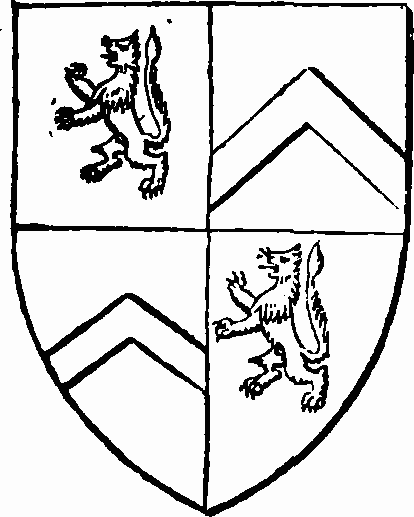
Girardot, of Allestrey. — John Charles Girardot, Esq. descended from an ancient French family, settled at Allestrey in the year 1805.
Arms, as granted by the Parliament of Dijon: — Quarterly, 1 and 4, Argent, a lion rampant, Sable. — 2 and 3, Gules, a chevron, Argent.

Gladwin, of Cold-Aston, temp. Jac. I., afterwards of Edelstow and Tupton, now of Stubbing. — The present representative of this family is Charles Dakeyne, Esq., Lieutenant-Colonel of the Derbyshire militia.
Arms: — Ermine, a chief, Azure, over all a bend, G. charged with a sword, Arg., hilt and pomel, Or.
Crest: — On a mount, Proper, a lion seiant, Arg. gutteé de sang, holding in his dexter paw a sword, Or.

Greaves, of Beely. — This ancient family took their name from a place called the Greaves or Greves in the parish of Beely, where they resided as early as the reign of Henry III. John Greaves, their descendant, in the reign of Queen Elizabeth, was a joint purchaser of the manor of Beeley, at which place they continued to reside till about the year 1700. The present representative of the Derbyshire branch of this family, is the Reverend George Greaves, rector of Stanton-by-bridge and Swarkston. There is another branch settled at Liverpool, but which of them is the elder we have not been able to ascertain.
Arms: — Per bend, Vert, and Gules, an eagle displayed, Or.
Crest:—An eagle displayed, Or, winged, Gules, issuing from a wreath.
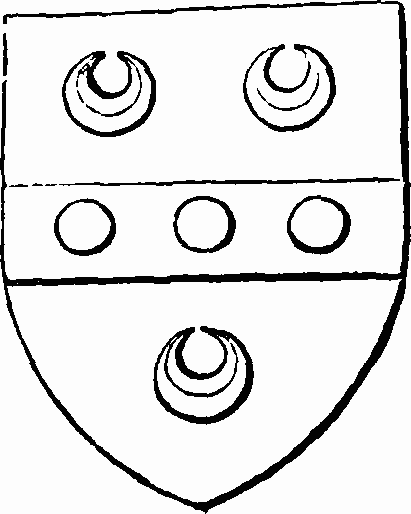
Hallowes, of Dethick, afterwards of Glapwell.—This family was originally of Hallowes, in Dronfield. Samuel Hallowes, of Dethick, married the heiress of Woolhouse, of Glapwell, about the middle of the seventeenth century. The heiress of the late Brabazon Hallowes, Esq., married Sir Robert Barker, Bart., since deceased: his nephew, Thomas Hallowes, Esq., now of Glapwell, is the representative of this family. The family of Hallowes disclaimed at the time of Dugdale's Visitation.
Arms granted in 1711: — Azure, on a fesse, Argent, between three crescents of the second, as many torteauxes.
Crest: —A demi-griffin rampant, Sable, winged, Argent.

Halton, of South-Winfield. — The first of this family who settled in Derbyshire was Mr. Immanuel Halton, steward of Henry, Duke of Norfolk, who died in 1699: he was the representative of the ancient family of that name, of Green-thwaite-hall, in Cumberland. The present representative of the family is Winfield Halton, Esq.
Arms: — Per pale, Gules and Azure, a lion rampant, Or.
Heathcote, of Little-Over. — It is probable that this family was originally of Heathcote, in the parish of Hartington. The first mention we find of them is in the reign of Edward IV., when they were engaged in mercantile concerns at Chesterfield. A family of Heathcote had been some time resident at Brampton in 1614, when they purchased Cutthorp in that parish. The immediate descendant and representative of the Heathcotes of Brampton is Cornelius Heathcote Rodes, Esq., of Barlborough, who took the name of Rodes in 1776, as before-mentioned. The ancestor of Bache Heathcote, Esq., now of Little-Over, was of Derby at the time of his death, in 1618. Samuel Heathcote, Esq., father of Bache, married the sister and heir of John Harpur, Esq., of Little-Over, who died in 1754. Gilbert Heathcote, alderman of Chesterfield, who died in 1690, was ancestor of both the Baronets of that name. Sir Gilbert, his eldest son, who was one of the founders of the Bank of England, and sometime Lord Mayor of London, was created a Baronet in 1733, and was ancestor of Sir Gilbert Heathcote Bart., of Normanton, in Rutlandshire. William Heathcote, nephew of Sir Gilbert, being son of Samuel, third son of the Alderman of Chesterfield, was created a Baronet the same year, and was ancestor of Sir William Heathcote, Bart., of Hursley, Hants.
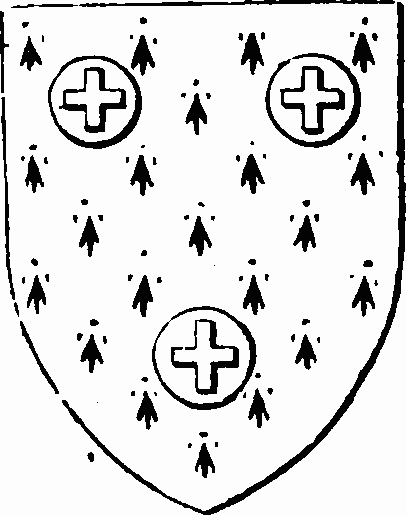
Godfrey Heathcote, of Chesterfield, was father of Ralph Heathcote, Rector of Stavely, from whom descended the Heathcotes of Sileby in LeiCharles, fourth son of James cestershire. Dr. Ralph Heathcote, Vicar of Sileby, was a controversial writer of some note in the early part of the last century: his son, Ralph Heathcote, Esq., was plenipotentiary at Cologne and Hesse-Cassel.
Arms of Heathcote: — Ermine, three pomeis, each charged with a cross, Or.
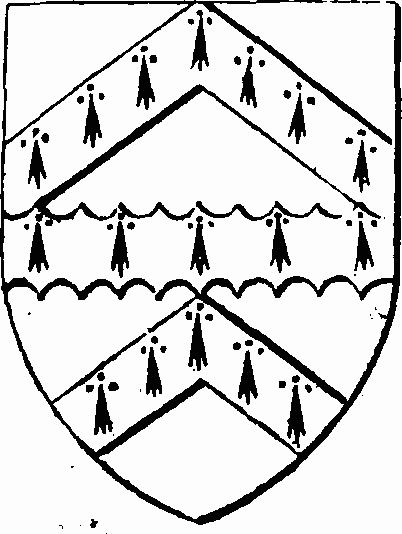
Holden, of Aston. — The first of this family of whom we find mention in Derbyshire was of Wilne; his son, Robert Holden, Esq., settled at Aston, and died in 1659. Robert Holden, Esq., the last heir male of the elder branch, died in 1746. Charles, fourth son of Jamès Shuttleworth, Esq., by the heiress of Holden, now the Rev. Charles Shuttleworth Holden, of Aston, took the name of Holden by sign manual in 1791, and had a grant of arms somewhat differing from those which had been borne by the Holdens (fn. n9), but were not allowed at the Heralds' College. Robert Holden, Esq., of Darley-Abbey, is the male representative of a younger branch of the Holdens, above-mentioned.
Arms: — Sable, a fesse engrailed, Erminois, between two chevrons, Ermine.
Crest: — On a mount, Vert, a heath-cock rising, Sable, winged, Or.
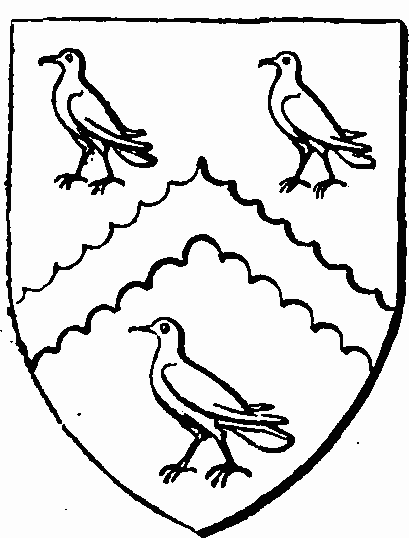
Hope, of Grange-field. — This family is traced to the reign of James I.; the present representative is the Rev. Charles Stead Hope, of Derby, whose father married the heiress of Stead.
Arms: — Argent, a chevron engrailed, Sable, between three Cornish choughs, Proper.
Crest: — A Cornish chough, rising, Proper.

Horton, of Catton.—This ancient family has been settled at Catton, now the seat of Eusebius Horton, Esq., more than 400 years. A younger branch, which became extinct in 1740, had settled at Coole-Pilate, in Cheshire, in the reign of Henry IV., in consequence of having married a coheiress of St. Pierre.
Arms:—Sable, a buck's head, caboshed, Argent, attired, Or.
Crest:—On the waves of the sea, Proper, a spear erect, Or, headed, Argent, enfiled with a dolphin of the first.
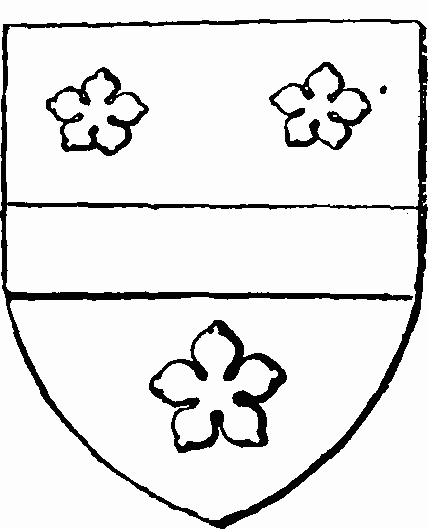
Hurt, of Alderwasley.—This family had been for five generations of Ashborne at the time of the Visitation of 1611. Christopher Hurt, of this family, married a coheiress of Blackwall, of Shirley. Nicholas Hurt, who settled at Alderwasley about the year 1690, in consequence of his marriage with the heiress of Lowe, of that place, was of Castern, in Staffordshire, near Ashborne. Alderwasley is now the seat of his greatgrandson, Francis Hurt, Esq.
Arms: — Sable, a fesse, between tbree cinquefoils, Or.
Crest (granted by William Flower, Morroy, to Hurt, of Ashborne): — A hart, statant, Gules, attired, Or, vulned or hurt in the flank, with an arrow of the second, fleched, Argent.

Jebb, of Walton. — Joshua Jebb, Esq., now of Walton, and Richard Jebb, Esq. of Tapton-grove, are grandsons of Joshua Jebb, Alderman of Chesterfield. Samuel Jebb, M.D., well known in the literary world, and John Jebb, Dean of Cashell, were brothers of the Alderman of Chesterfield. Dr. Samuel Jebb was father of Sir Richard Jebb, Bart, the late eminent physician; the Dean of Cashell was father of Dr. John Jebb, a well known controversial and political writer who died in 1786.
Arms of Jebb: — Quarterly, Vert and Or; in the first quarter, a falcon close, Argent, belled of the second; in the fourth, a hawk's lure of the third.
Longsdon, of Little-Longsdon.—This ancient family is descended from Matthew, a son of Thomas, Rector of Bakewell; who, before the reign of Edward I., having settled at Little-Longsdon, was called "De Parva Longsdon," and his posterity afterwards Longsdon. The present representative is James Longsdon, Esq., of Little-Longsdon.
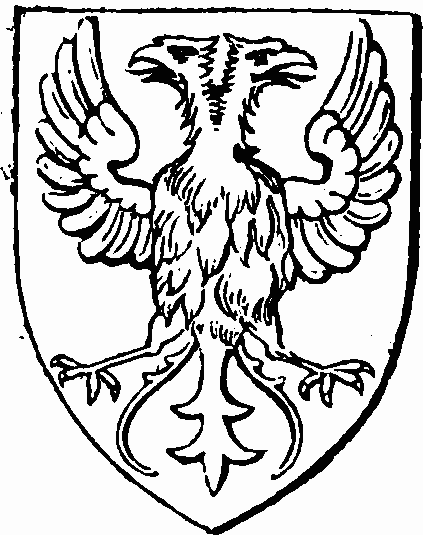
Arms: — An eagle displayed, with two heads.
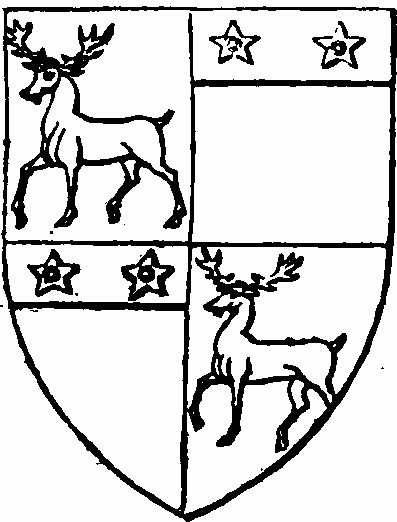
Lowe, of Denby and Locko. — This ancient family is said to have been originally of Cheshire. They settled at Denby, in or about the reign of Henry VI. in consequence of the marriage of Lawrence Lowe, Esq., serjeant at law, with the heiress of Rosell. Richard Lowe, Esq., the last heir male of this family, died without lawful issue, in 1785: he bequeathed the estates of Denby and Locko to William Drury, a distant relation, who in 1791, pursuant to his will took the name (in addition to that of Drury) and the arms of Lowe (to be borne quarterly). William Drury Lowe, Esq. is the present proprietor of Locko.
Arms:—I and 4, Azure, a hart trippant, Argent;
Lowe. — 2 and 3, Arg. on a chief Vert, two mullets, Or, each charged with an annulet, Azure; Drury.
Crest of Lowe: — A wolf passant.
Crest of Drury: — A greyhound current, Sable, gorged with a plain collar, Or, and charged with two mullets of the last.
Thomas Lowe, of the Denby family, having married the heiress of Fawne, or Fowne, of Alderwasley, settled at that place in or about the reign of Henry VII. The sole heiress of this branch married Hurt, not long before the close of the seventeenth century.
Mellor, of Mellor and Ideridge-hay.— The Mellors were descended from a younger son of Simon de Stavely, who settled at Mellor in the reign of Henry III. The coheiresses of the elder branch of Mellor married Radcliffe, Stafford, and Ainsworth, about the middle of the fourteenth century. A family of this name, supposed to be a younger branch, was of Ideridge-hay as early as the reign of Henry VII. Mr. Samuel Mellor, the representative of this family, who died in 1795, left no male issue surviving; his grand-daughters and coheiresses married Cresswell and Cock. His nephew, Thomas Mellor, Esq., is the present heir male of this family.
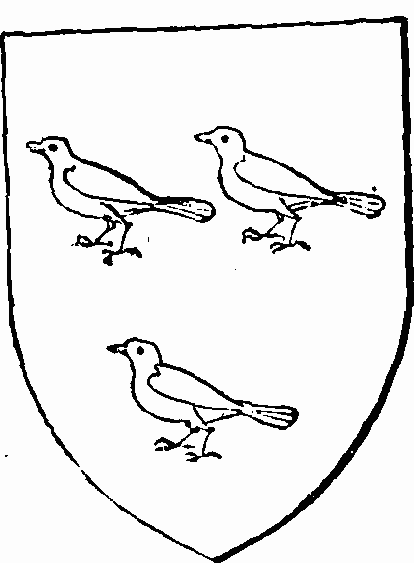
Arms:—Argent, three blackbirds, Proper.
Meynell, of Meynell-Langley, Willington, and Bradley.— This ancient family was settled in Derbyshire at an early period. Hugh de Meinell, who was of Langley-Meinell in 1251, married the heiress of Edensor, his grandson, Sir Hugh, the heiress of Ward, of Stanton-Ward, in Stapenhill. Another Sir Hugh, who was of Newhall in Stanton, and of Langley-Meynell, married a daughter of Lord Bassett, of Drayton, who, through her mother, was heiress of Everdon. One of the three coheiresses of Ralph Meynell, who died in 1387, married Staunton; the other two into the Dethick family. Bassett of Blore married the heiress of Dethick, and the heiress of Bassett of Blore, William Cavendish, afterwards Earl and Duke of Newcastle.

A younger branch of this family, descended from William Meynell, of Yeavely, brother of Ralph above-mentioned, settled at Willington, about the year 1500. The immediate descendant and representative of this branch is Godfrey Meynell, Esq., of Bradley, whose ancestor Francis purchased that place in 1655: his father, Godfrey, was at that time the representative of the Willington and Yeavely branches. Godfrey Meynell, Esq., now of Meynell-Langley, is the representative of Francis Meynell, Esq., younger brother of Godfrey before mentioned, which Francis settled at Anslow, in Staffordsbire, m the reign of Charles I.
Arms:—Vaire, Argent and Sable. (fn. n10)
Crest: — A horse's head, erased, Argent.
Middleton, of Leam, in Eyam. — Robert Middleton, the last heir male of this family, died in 1736. His daughter and heir married Mr. Jonathan Oxley, of Sheffield; pursuant to whose will, Marmaduke Carver (son of the Rev. Mr. Carver, of Mortham, in Yorkshire) took the name of Middleton in 1795, and is the present proprietor of Leam.
No arms were entered at the Heralds' College at the time of the change of name.
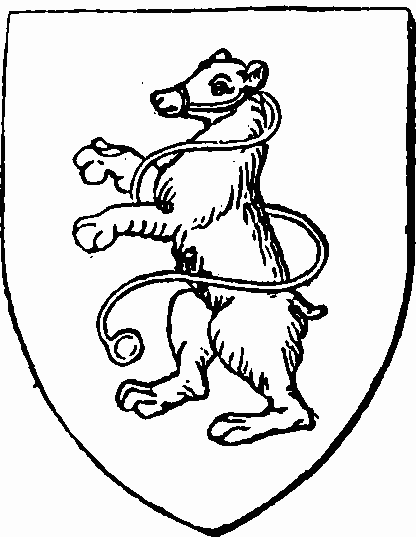
Milnes, of Tapton-hall, Aldercar, Dunston, and Cromford.— The family of Milnes is traced to the reign of Queen Elizabeth. Richard Milnes, Alderman of Chesterfield, who died in 1628, was ancestor of the Milnes's of Aldercar, Dunston, and Cromford. Richard Milnes, Esq., of Aldercarpark, was Sheriff in 1720; William Milnes, Esq., of Cromford, in 1771. Richard Milnes, elder brother of this William, was of Dunston: his only child who left issue was a daughter, married to Robert Mower; by whom she had a daughter (her only surviving child), now widow of the late Thomas Smith, Esq., of Dunston. William Milnes, Esq., above-mentioned, who acquired Cromford in marriage with the heiress of Soresby, had a grant or confirmation of arms in 1795, and died without male issue in 1797. One of his coheiresses married Smith; another, Lee, and afterwards Pegge; and the third, Gell, of Hopton. Richard Milnes, Esq., of Chesterfield, nephew of William above-mentioned, is the male representative of Milnes of Dunston and Aldercar; he is unmarried. Mr. Gell, of Hopton, is the representative, in the female line, of Milnes of Cromford and Aldercar. The other coheiresses left no issue.
Arms of Milnes, of Dunston, Aldercar, and Cromford: — Or, a bear rampant, Sable, muzzled, collared, and lined, Gules.
Crest: — A bear's head, couped, at the neck, Sable, charged with a mill-rind, Or.
James Milnes, who settled at Tapton-hall, was a younger brother of Richard Milnes, Alderman of Chesterfield, before-mentioned. This branch became extinct in the male line in 1717. The sisters and coheirs of the last heir male married Revell and Brailsford. The Yorkshire branch (of which is Sir Robert Shore Milnes, created a Baronet in 1801) derives its descent from Richard Milnes, of Chesterfield, a younger brother of James Milnes, Esq., of Tapton-hall; which Richard died in 1706.
Morewood, of Alfreton. — This family resided at Staden, in Bakewell, previously to the reign of Henry VIII., when Rowland Morewood married one of the coheiresses of Stafford, of Eyam; some of the descendants settled at Alfreton. One of the coheiresses of Anthony Morewood, who died in 1636, brought Alfreton to the Honourable Alexander Stanhope; but it reverted to the male line. John Morewood, Esq., of Alfreton, had a grant of arms in 1678: his descendant, George Morewood, Esq., died without issue, in 1792. The Rev. Henry Case, Rector of Ladbrook, in Warwickshire, who married his widow, took the name of Morewood by sign manual, in 1793, with licence to quarter the arms of Morewood and Case.
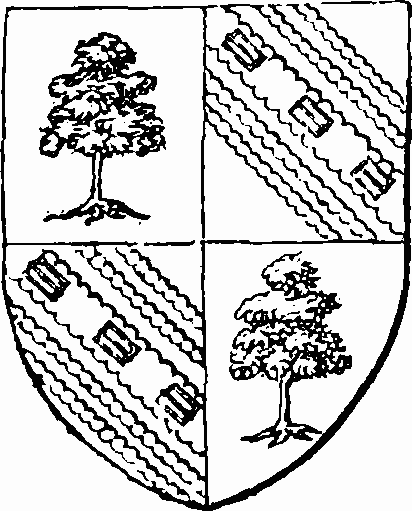
Arms:—1 and 4, Vert, an oak-tree, Argent, fructed, Or; Morewood.—2 and 3, Or, on a bend, invecked, Azure, double cottised, Gules, three square buckles of the first; Case.
Crest of Morewood:—A dexter and sinister arm, armed, Proper, supporting a chaplet of oak-branches, Vert, acorned, Or.
Crest of Case: — A cubit arm, armed; in the hand,. Proper, a bugle-horn, Sable, stringed, Gules, between two oak-branches, Proper, fructed, Or.
Some of the descendants of Rowland Morewood and Catherine Stafford were settled in the parish of Dronfield. Andrew Morewood, of the Hallows in that parish, who died in 1678, left several daughters coheiressesWe can learn nothing further of this branch.
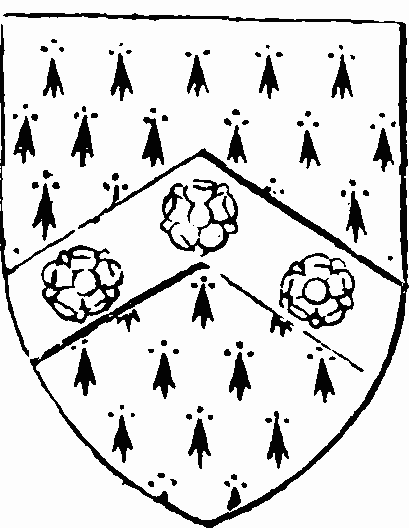
Mower, of Woodseats. — The ancestor of this family married the heiress of De Mora, with whom he had Woodseats, in or about the reign of Henry VI. The present male representative of this family, into which the coheiresses of Hewgate, Kinge, Sheldon, Prichard, and Johnson have married, is George Mower, Esq., now of Holt-house, in Darley. There was a younger branch of this family at Holmes-field. George Mower, of this branch, had two sons, Robert and James, living in 1651. We can learn nothing further of this branch.
Arms: — Ermine, upon a chevron, Azure, three roses, Gules.
Mundy, of Markeaton.—Sir John Mundy, Lord Mayor of London, a native of High-Wycombe, in Buckinghamshire (fn. n11), settled in Derbyshire in the reign of Henry VIII., having purchased Markeaton of Lord Audley. The present representative is Francis Mundy, Esq.

Arms: — Per pale, Gules and Sable, on a cross, engrailed, Argent, five lozenges, Purpure; on a chief, Or, three eagles' legs, erased, a-la-quise, Azure.
Crest: — A wolfs head, erased, Sable, bezantee; fire issuing from his mouth, Proper.
Mundy, of Shipley. — Edward Mundy, Esq., descended from a younger branch of the Mundys of Markeaton, and father of Edward Miller Mundy, Esq., now of Shipley, one of the representatives for the county, married the heiress of Miller, who had married the heiress of Leche, the former possessors of that place.
Arms, the same as Mundy of Markeaton, with due difference.
The heiress of a younger branch of Mundy of Markeaton, settled at Quarndon, married Musters.

Newton, of Horsley and Mickle-Over. — This family, being descended from the Newtons of Newton, in Cheshire, settled at Horsley about the year 1500. The descendants of the elder son of Roger Newton, Esq., of Chaddesden, whither the family had removed, settled at Duffield. This branch became extinct by the death of Timothy Newton, whose heiress married Hancock of Brampton. Robert Newton, son of Roger by his second wife, settled at Mickle-Over, and died in 1611. This branch became extinct in the male line by the death of Robert Newton, Esq., in 1789. John Leaper, Esq., descended from a sister of the late Mr. Newton's father, took the name and arms of Newton, by sign manual, in 1790. He served the office of Sheriff in 1798, still possesses the house and estate at Mickle-Over, but is at present resident at Clifton, near Bristol.
Arms: — Sable, two human shin-bones, in saltier, Argent.
Crest: —A naked man, kneeling on his sinister knee, and holding a sword, Proper, the point downward, hilt and pomel, Or.
Nightingale, of Lea. — Peter Nightingale, Esq., purchased this estate in 1707. By the will of Peter Nightingale, Esq., who was sheriff of the county in 1770, his great nephew, William Edward Shore, Esq., took the name of Nightingale in 1815. He resides at Lea-wood house near Cromford. No arms were entered when the change of name took place.
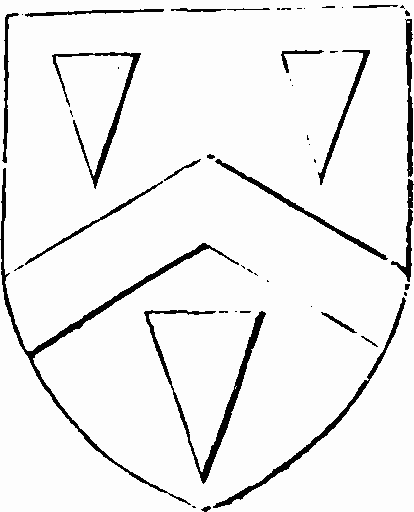
Pegge, of Beauchief.—The Pegges were for several generations of Yeldersley near Ashborne. (fn. n12) Mr.William Pegge of Yeldersley, the last of the elder branch died without issue in 1768. Edward Pegge, Esq., who became possessed of Beauchief-abbey by marrying the heiress of Strelley died in 1679. The present representative of this family is Peter Pegge Burnell, Esq. Another branch of the Pegges was of Osmaston near Ashborne. Dr. Samuel Pegge, the antiquary, was of this branch; and his grandson, Sir Christopher Pegge, M.D., Professor of Physic in the University of Oxford, is its present representative.
Arms of Pegge of Beauchief and Osmaston: — Argent, a chevron between three piles, Sable.
Crest:—A demi-sun issuing from a wreath, Or, the rays alternately Argent and Sable.

Pole, of Radborne. — The Poles are said to have been of an ancient Staffordshire family; but they had been for some time of Hartington in this county, before the marriage of Sir John de la Pole with the heiress of Wakebridge, in the fourteenth century. Peter his son, married a daughter of Sir John Lawton, who was heiress, on her mother's side, of Sir John Chandos. Ralph, son of Peter, was appointed one of the justices of the King's-bench in 1452. Ralph, his eldest son, was of Radbome, and married the heiress of Motton. The elder branch of the Radborne line became extinct by the death of German Pole, Esq., in 1683, when Radborne and other-estates passed, under his will, to Samuel Pole, Esq., of a younger branch settled at Lees, immediate ancestor of Edward Sacheverel Chandos Pole, Esq. now of Radborne. One of the coheiresses of Sacheverel of Morley, married the present Mr. Pole's great-grandfather.
Arms of Pole of Radborne:–Argent, a chevron between three crescents, Gules.
Crest: — A hawk rising, Proper.
John, a younger son of Ralph Pole the judge, settled at Wakebridge, where his descendants continued till the year 1724, when John Pole, Esq., the last heir male of this branch died leaving a sister and heir married to Morphy. A younger branch of the Poles of Wakebridge, was settled at Park-hall in Barlborough. This branch became extinct in 1750, by the death of Francis Pole, Esq.
Henry, another younger son, of Ralph Pole the judge, settled at Heage, where his father also appears to have had a seat in the reign of Henry VI.; he married a coheiress of Dethick. The last heir male of this branch died some time in the seventeenth century: the coheiresses married Frith and, Chaworth.
The Poles of Wakebridge bore in addition to their ancestors' arms, a canton, Azure; those of Heage, a canton Gules.
Rodes of Barlborough. See extinct Baronets.
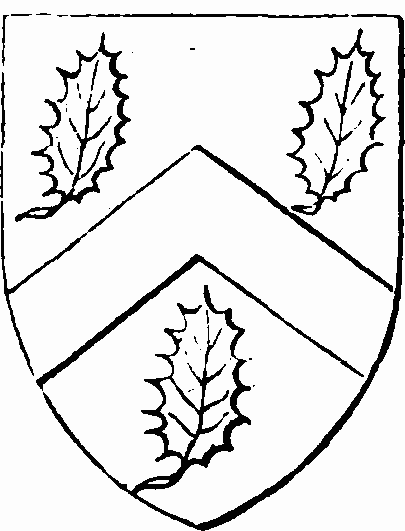
Shore, of Mearsbrook and Norton-hall. — Samuel Shore (fn. n13), of Sheffield, father of Samuel Shore, Esq., now of Mearsbrook, and grandfather of Samuel Shore, Esq., now of Norton-hall, purchased Mearsbrook in the parish of Norton, and retired thither in the latter part of his life. Mr. Shore, of Mearsbrook, who was sheriff of the county in 1761, married a coheiress of Offley; his son, Mr. Shore of Nortonhall, a coheiress of Foye.
Arms: — Argent, a chevron, Sable, between three holly leaves, Vert.
Crest: — A stork, holding in the dexter claw, a pebble of the sea shore.

Shuttleworth, of Hathersage. — The father of Ashton Ashton Shuttleworth, Esq., now of this place, married the heiress of Spencer of Yorkshire, who had married the heiress of Ashton of Hathersage. (fn. n14)
Arms:–Argent, three weavers' shuttles, Sable, tipped and quills furnished, Or.
Sitwell, of Steynesby.–Edward Sacheverell Wilmot Sitwell, Esq., who purchased this place about the year 1782, is grandson of Richard Wilmot, D.D., Rector of Morley, youngest son of Robert Wilmot, Esq., of Chaddesden, by Joyce Sacheverell, sister of the last Sacheverell, of Morley. His elder brother, Richard Staunton Wilmot, took the name of Sitwell in addition to that of Wilmot, pursuant to the will of Mrs. Elizabeth Sitwell, (daughter and heir of George Sitwell, Esq.,) who died in 1769. On the death of Richard Staunton Wilmot Sacheverell, Esq., in 1772, his brother Edward Sacheverell Wilmot took the name of Sitwell.
Arms: — Sitwell and Wilmot quarterly. (fn. n14).
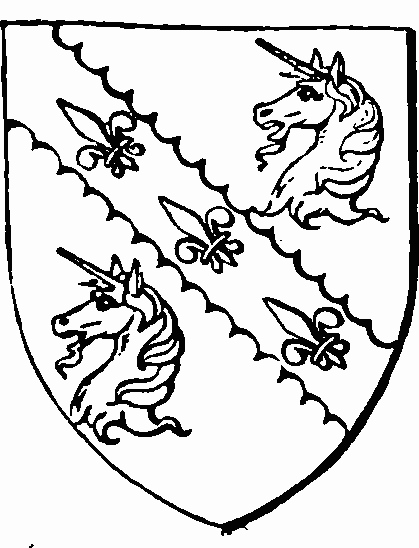
Smith, of Dunston. — The late Thomas Smith, Esq., of a Yorkshire family, acquired Dunston in marriage with the daughter and only child of Robert Mower, Esq., by his first wife, who was eventually sole heiress of Milnes of Dunston. The eldest son is just of age.
Arms granted in 1816. — Argent, on a bend, engrailed, Azure, between two unicorns' heads erased, Gules, three fleurs de lis, Or.

Strelley, of Shipley, Beauchief, and Ulkerthorpe. — The Strelleys were an ancient Nottinghamshire family. Philip de Strelley had a share of the manor of Repton in 1232. About the beginning of the fourteenth century, a branch of this family settled at Shipley, in consequence of a marriage with the heiress of Vavasor. Shipley passed from the Strelley family in the reign of Queen Elizabeth. Sir Nicholas Strelley had a grant of Beauchief- Abbey in 1536. The Beauchief branch of this family became extinct about the middle of the sixteenth century. Edward Pegge, Esq., who married the heiress, died in 1679. Benjamin Strelley, Esq., of Okerthorp or Ulkerthorpe in South-Winfield, is descended from Philip Strelley, citizen and goldsmith, of London, who died seised of Ulkerthorpe in 1603, and is supposed to have been of a younger branch of this family.
Arms: — Paly of six, Arg. and Azure.

Thornhill, of Stanton. — The grandfather of Bache Thornhill, Esq., now of Stanton, being descended, as appears from family documents, from the Thornhills, of Thornhill in the Peak (fn. n15), married Ann, the daughter and heir of Henry Bache of London, and niece and heir of Raphael Bache, Esq., of Stanton, in the year 1697.
Arms borne by Thornhill of Stanton as granted in 1734: — Gules, two bars gemelles, Argent, a chief of the second, with the addition of a mascle, Sable, thereon for difference.
Crest:—A mount; thereon a thorn-tree, Proper, charged on the branches with a mascle, Or.

Turbutt, of Ogston. — Richard Turbutt, Esq., of Doncaster, who married one of the coheiresses of Revel of Ogston, in the early part of the last century, was the immediate ancestor of William Turbutt, Esq., now of Ogston.
Arms: — Azure, three turbots, Argent, finned, Or.
Crest: — A naked arm holding in the hand, Proper, a trident, Or, armed and headed, Argent.
Wilkinson, of Hilcote-hall: — The ancestor of John Wilkinson, Esq., now of Hilcote-hall, settled at that place about the beginning of the last century, and died in 1721. The elder son of his son John Wilkinson, Esq., assumed the name of Lindley in 1782. Hilcote-hall was settled on the issue of Stephen, a younger son, who was grandfather of the present Mr. Wilkinson.

Arms: —Gules, a fesse, Vaire, in chief an unicorn passant, Or, all within a border, Sable bezantée.
Crest: — A fox's head, couped, per pale, V. and Or, holding in his mouth a dragon's wing, Arg.

Wolley, of Riber and Allen-hill. The family of Wolley are of considerable antiquity in Derbyshire; the name occurs among those of the gentry returned by the commissioners in the reign of Henry VI. Two branches of this family were for many generations settled at Riber and Allen-hill, in Matlock. The Riber branch became extinct by the death of Anthony Wolley, Esq., in 1668. Mr. John Wolley, of London, grocer, is the representative of the Allen-hill branch. His younger brother, Mr. Adam Wolley, to whom we have been indebted for so much valuable assistance, resides at Matlock-Bath. A younger branch of the Wolleys of Allen-hill, (some time extinct,) was, for several generations, of Marston-on-Dove. Mr. William Wolley, who wrote a MS. history of Derbyshire about the year 1712, was of this branch.
Arms: — Sable, a chevron vaire, Or, and Gules, between three maidens' heads couped, Proper, crined of the second.
Crest: — A man's head, (side face, with a beard,) issuing from a wreath, Proper.
Wolstenholme, of Horsley.gate, in the parish of Dronfield. — A younger branch of the ancient family of Wolstenholme, of Wolstenholme in Lancashire, settled at this place about the year 1450. A younger brother of this branch, who went to London about the middle of the sixteenth century, settled at Stanmore in Middlesex, and was ancestor of Sir John Wolstenholme, who was created a baronet in 1664. The title and the Stanmore branch became extinct by the death of the late Sir Francis Wolstenholme, the sixth baronet. The present representative of the elder line of the Horsley-gate branch which continued in Derbyshire is the Reverend Hugh Wolstenholme, curate of Crich, whose father having a small estate and a numerous family, sold his ancient patrimony at Horsley-gate.

Arms: — Azure, a lion passant guardant, between three pheons, Or.
Crest: — An eagle displayed, Or, treading on a snake, nowed in fret, Azure.


